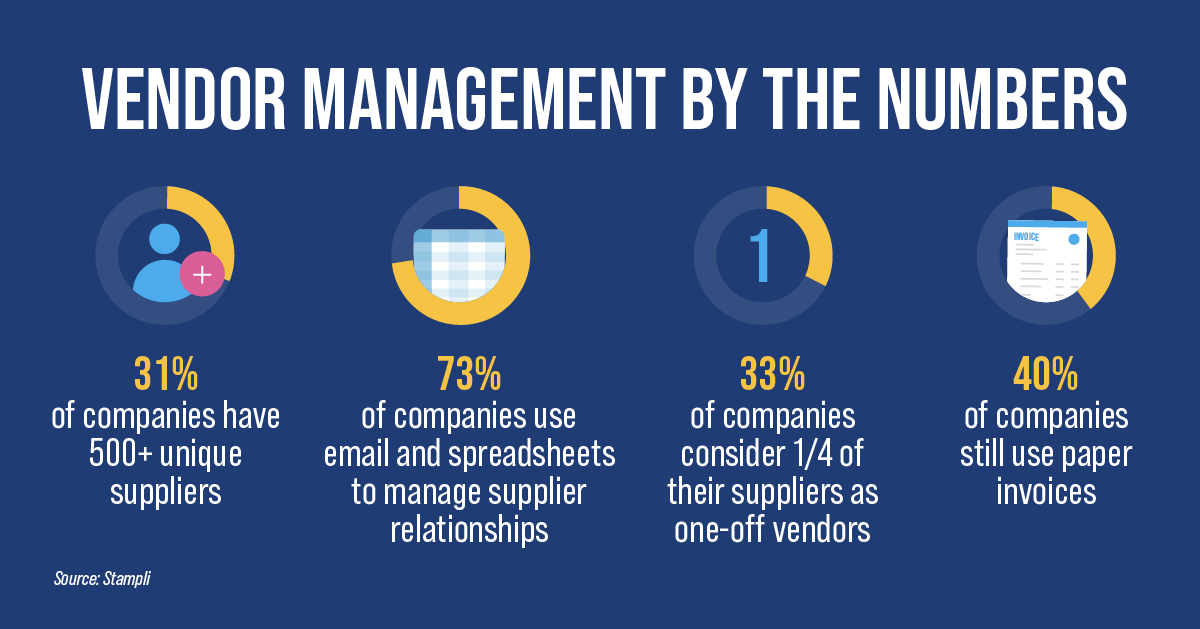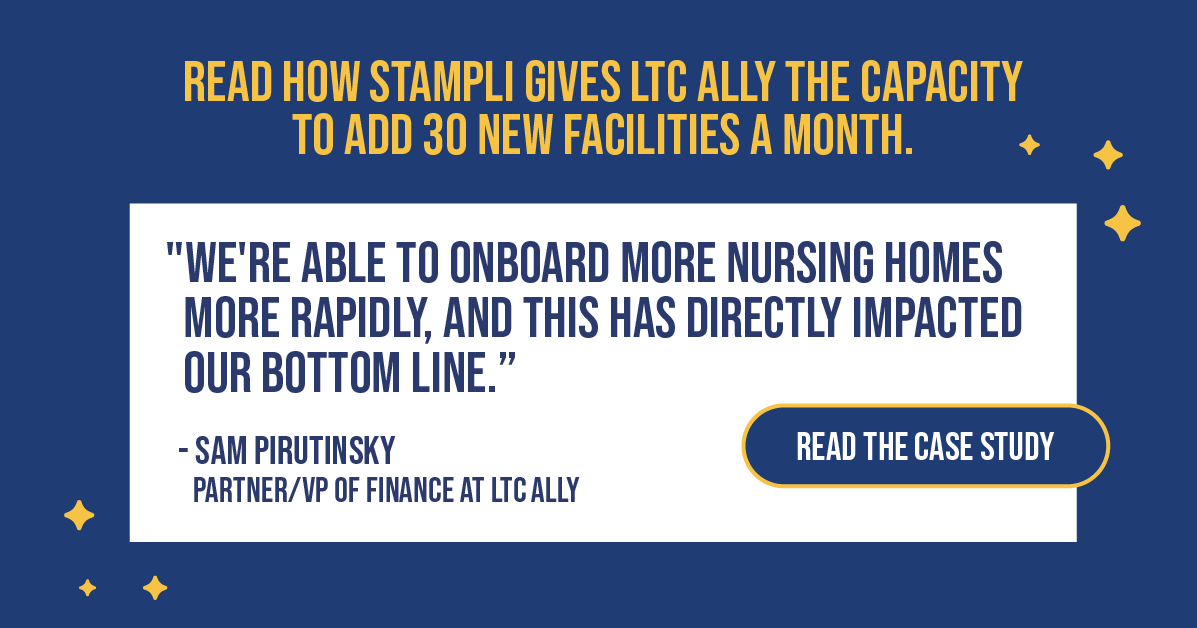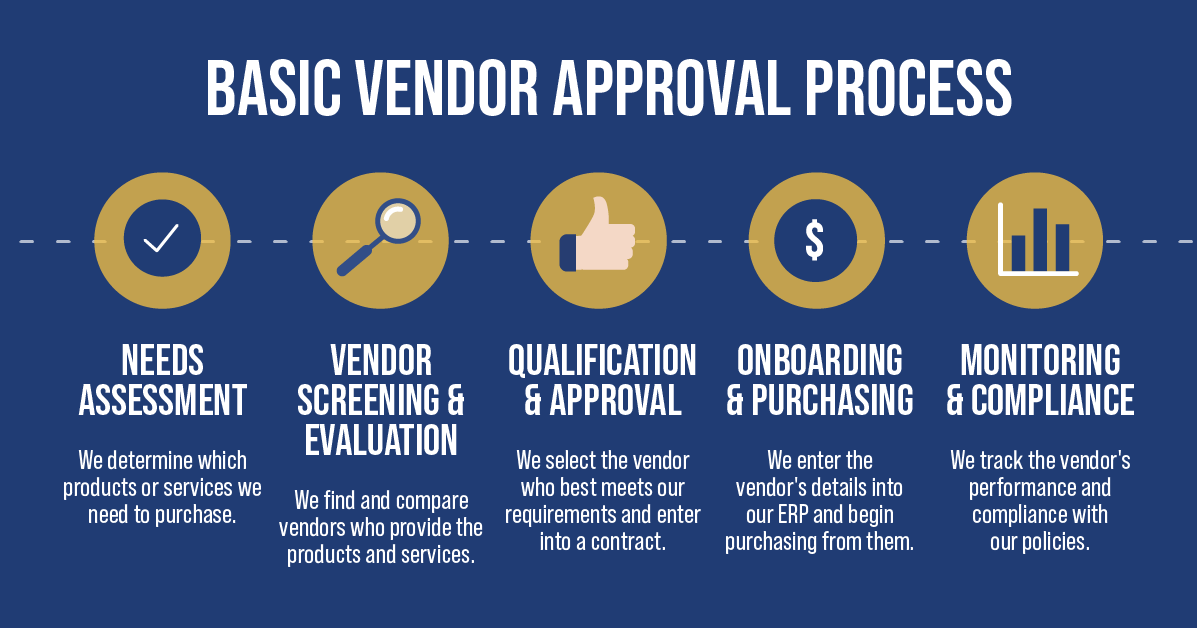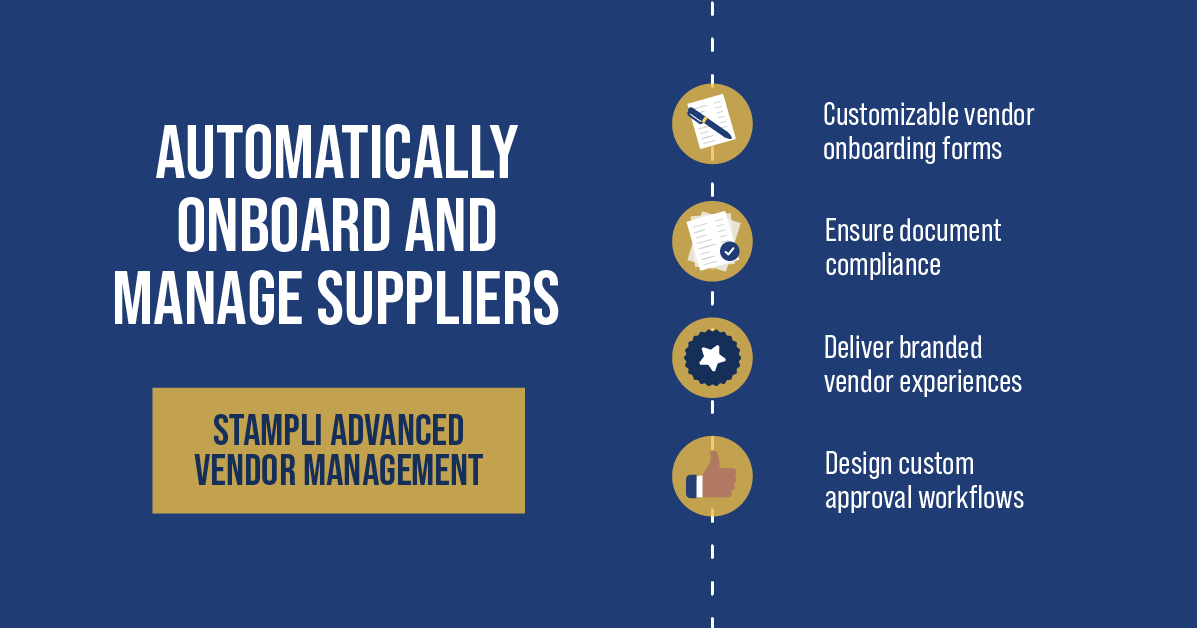The Art of Building a Flawless Vendor Approval Process

How you choose, approve, and manage your vendors has a direct impact on your company’s health.
Finding reliable vendors who supply quality goods and services is crucial for the health of your supply chain. The best vendors invest in your success and work alongside you to help grow your business. This article will explore the benefits of setting up a robust vendor approval process. It will help you find and engage the right vendors and cultivate strong, positive vendor relationships.
What is the vendor approval process?
The vendor approval process is sourcing, selecting, approving, and onboarding suppliers for your organization. For most businesses, it’s a significant and complex task. For instance, in Stampli’s survey of 282 finance leaders across the US, AP Today: Bottlenecks, Benchmarks, and Best Practices, 31% of companies said they had at least 500 unique vendor relationships. A strong vendor approval process lowers the difficulty and risk of onboarding vendors.

Before we get into the vendor management process, it’s important to understand that businesses engage with vendors in several ways. We’ll use a scenario to illustrate how this breaks out.
I’m the CFO of a community health services provider. We own and operate medical and dental centers where people can go for basic medical care. The business has complex procurement needs ranging from office supplies to medical equipment to construction.
We usually buy goods and services in one of four ways:
- Through a formal request for information/request for proposal (RFP) process. For example, when we’re building a new healthcare center, we may issue an RFP inviting building contractors to bid on the work.
- Through an informal selection process where our procurement team selects a vendor to provide a product or service without an RFP process. For example, one of our operations managers may ask our procurement team to add a commercial cleaning service to clean our locations.
- As a one-off supplier where we use a vendor only once to provide a product or service. For example, one of our centers may hire a caterer to provide food and beverages for a social event.
- As an expense when an individual employee purchases a good or service. For example, if one of our employees is traveling, they may incur costs for hotels and meals.
Although each scenario may differ, we approach them all similarly. The only exception is employee expenses, which we handle through a separate process. Our vendor approval process comprises five key steps to identify, choose, and engage suppliers. It’s a great process, and it works very well because it’s based on one thing – preparation.
Prepare a vendor approval policy
Our supplier onboarding process includes five steps from needs identification to vendor relationship management. Before we talk more about those steps, I want to talk about how we created our vendor approval process.
In our early years we didn’t have a purchasing process. We managed our vendors on an as-needed basis. We selected vendors as needs arose, and vendor onboarding was usually a matter of adding the vendor’s name and address to our accounting system. As we grew, this ad hoc process didn’t work for us anymore. We fell behind on payments, made lots of mistakes, and annoyed a lot of our vendors. So, we sharpened our pencils and created a vendor approval policy to rework our existing processes.
Our vendor approval policy lays out the roles and responsibilities, vendor selection criteria, and risk management policies that form the foundation of our vendor approval process. Let’s look at these elements.

Assign roles and responsibilities
First, we decided who would handle the various stages of choosing and onboarding vendors. Doing this lets us control who can add and approve new vendors, which cuts down a lot on unauthorized vendors and purchases.
For instance, we required all purchases to go through our procurement team. If anyone wants to add a vendor or make a purchase, procurement manages the process for them. We also set vendor approval levels on spend amount and vendor type—for example, as the CFO, all contracts over $500,000 land on my desk for approval.
Set vendor selection criteria
Next, we set out the rules and criteria for selecting and assessing vendors. The rules and criteria balance flexibility and risk management while ensuring vendors align with our values.
Manage risk
Our controller likes to say that any time you add a new vendor, you add potential risks. Risk is an unavoidable part of doing business. To better protect ourselves, we developed a risk assessment policy for our vendor approval process. Here are some key elements of our policy:
- We require all vendors to stay compliant with applicable regulations. For example, vendors must provide us with valid copies of proof of all applicable insurance, licenses, and certifications before we do business with them. We also require vendors to keep key documents current with us.
- We conduct background checks on all new vendors and require them to perform criminal record checks on any employees who will work on our premises or accessing our data.
- We assess vendors on their ability to deliver the expected level of service—do they have the expertise and experience to work in health care, and what level of support do they provide?
- Where applicable, we assess a vendor’s security risk and policies. For example, if we were sharing patient records with a vendor, we would ask them to prove they have data security measures in place.
There’s no way to eliminate risks entirely, but having a basic risk management policy helps protect us from foreseeable risks becoming problems later.
Create a vendor approval process
Finally, we laid out the five steps of our vendor approval workflow. Our vendor management policy informs each step, so everyone knows their role, how to assess vendors, and how to manage risks.
Taking the time to prepare our vendor approval policy lets us build a solid foundation for our vendor approval processes. This has several benefits for our business:
- The policy lets us ensure we find and engage the best vendors
- It helps us save money by reducing overhead and risk
- Our process makes the onboarding process easier for us and our suppliers
Let’s look at the five steps of the process.
Steps of the vendor approval process

I like to say that our vendor approval process is like our company’s welcoming committee—it starts things off right between us and our new vendors. Our process ensures that everyone in the procure-to-pay chain is on the same page and we select and onboard top-quality vendors.
Our process is slightly different for different purchase types, but it usually follows the same path for each vendor. I’ll point out areas where the workflow might vary.
The process starts with a needs assessment.
Step 1: Needs assessment
Every purchase starts with a business need our company can’t easily provide for itself and must buy from a supplier. Our needs assessment process includes:
- Identifying a business need
- Defining what we need from a supplier
- Deciding how we want to approach suppliers to fulfill that need
For instance, we may need a bunch of desks for a new office, and we want to get them from our existing office furniture supplier. In that case, we’d identify the need (desks), what we need the supplier to provide (number of desks, size, color, style, features), and how we want to approach the supplier to provide the desks (purchase order).
Sometimes, we may identify a business need but not completely understand how we want that need filled. In that case, we may issue a Request for Information (RFI) to potential suppliers inviting them to help us understand the need better. Once we get a better understanding of the need, we may follow the RFI up with a Request for Proposals inviting vendors to offer proposals to solve the business need.
However we do it, once we’ve assessed our needs, we move to vendor screening and evaluation.
Step 2: Vendor screening & evaluation
After identifying the business need, we identify and evaluate potential vendors who can supply a solution to the need. As I mentioned, the screening and evaluation process can be as informal as our procurement team researching vendors on the internet, or it can be a formal RFI/RFP process. Whatever the case, we use a similar approach to how we screen and assess potential vendors.
Our vendor selection process involves finding potential vendors, evaluating their capabilities, reputation, and risk profile, and selecting the best fit for our needs. We use a variety of different ways to screen and evaluate vendors, including vendor checklists, RFI/RFPs, interviews, and vendor forms such as questionnaires or applications.
Depending on the size and importance of the purchase, vendor selection could fall to a single procurement team member, or it could be a major project involving a team of stakeholders from different departments.
When we’re assessing vendors, we look at things like pricing and quality, capability, service level, and reputation, but we also weigh intangibles like how well the vendor communicates and how they can help us build and develop our business.
Step 3: Vendor qualification & approval
After we’ve chosen a potential vendor, we begin qualifying them pending approval. Our qualifying process depends on the situation.
For low-risk vendors like office supply companies, Procurement may do a simple review and approve the vendor themselves. For larger or high-risk purchases, we might perform a risk assessment and an analysis of the vendor’s capabilities and financial stability. And for vendors who will access patient data, we may ask to perform an audit of their security and privacy policies and procedures, or ask for proof they comply with privacy regulations.
Finally, for some vendors, such as technology providers, we may ask for a test run of their proposed solution to see if it meets our needs.
Once the vendor qualification is complete, we’ll approve them as a supplier and begin the onboarding process.
Step 4: Onboarding & purchasing
Our vendor onboarding process involves collecting the vendor’s information to get them into our system, purchase from them, and pay them. We also collect documents and information from the vendor to ensure they comply with our policies and government regulations.
In simple cases, onboarding can be as simple as one of our accounts payable clerks sending a vendor information form to an approved vendor, having the vendor fill it out, and manually entering the info into our ERP. The vendor info includes contact information like the vendor’s name and address, tax information, key contacts, bank account information, default currency, and payment terms.
In more complex cases, we might need to:
- Gather more detailed information (insurance certificates, licenses, proof of compliance)
- Integrate the vendor into our business processes
- Set up the vendor in one of our offices
Once we set up the vendor in our system, we can begin purchasing products and services from them.
Step 5: Monitoring & compliance
The last step in our vendor approval process is ongoing monitoring and compliance. Monitoring involves regularly checking the vendor’s performance on quality, timeliness, and support against their committed service levels and our benchmarks. Monitoring is a terrific way to identify top-performing vendors, and it also helps us improve vendor relationships. If we note an area for improvement with a vendor, we can contact them and show them exactly where the problem lies, which makes it much easier for them to address it.
It’s also crucial for our vendors to comply with our policies and government regulations. That means we need to make sure each vendor’s documentation is always up to date. Our procurement and legal teams regularly monitor our list of vendor documents and inform vendors when a document is going to expire and needs to be updated.
Now that I’ve walked you through our basic process, let’s look at a few things we’ve learned about vendor approvals along the way.
Tips and best practices for vendor management
Building a vendor approval process can be a tough job, especially if you’re starting in the middle like we did. Here are a few tips and tricks that can help you get it right:
Do your homework
When you’re screening and evaluating vendors, get as much information as you can about each one. Look at their reputation, capabilities, business operations, and competitors. Doing this will ensure you go into negotiations completely informed, and it also helps you avoid nasty surprises.
Put communications first
Insist on open communications with potential vendors. Be as clear as possible about your expectations, deadlines, and requirements, and ensure vendors completely understand them. Similarly, look for vendors who are clear, honest, and upfront about functionality, pricing, and risks.
Centralize vendor information
Currently, we manually enter our vendor records, information, and documents into our ERP, and track contracts and compliance documents in Excel. This isn’t a perfect system, and it makes it hard to ensure the data and docs are up to date.
A better solution is to have an automated system and central database to manage vendor documents. Putting everything in one place makes it easier for us to track, search, and access vendor information. It also keeps things from getting lost or stuck in the wrong place. And best of all, an automated vendor document management system keeps track of when documents are going to expire and sends a notification to the vendor to renew them.
Automate vendor onboarding
Creating a vendor approval policy and process was a significant change for us. It let us get on top of our vendor onboarding and it made a big difference in the quality of our supplier relationships. That said, there are still some areas for improvement. We still rely on manual processes for onboarding, vendor record-keeping and tracking, and compliance. These processes are slow and error-prone, and they put us at risk of non-compliance with regulations.
That’s why we’re making the move to automated vendor management for our vendor approval processes. Vendor approval process automation is an effective way to streamline manual processes and centralize and track vendor data. Here are some benefits to our business:
Automated onboarding
The vendor management system sends an information form to the new vendor, automatically reminds them to complete it, and checks the form for completeness when the vendor returns it. Once the vendor returns the form, the system automatically creates a vendor record.
Compliance monitoring
The advanced vendor management portal ensures vendors submit required documents such as insurance policies and certificates. The system reminds vendors to submit their documents and gives us the option to withhold payments from vendors who haven’t sent their documents. It also tracks document expiration dates and sends the vendor a reminder to upload updated versions of documents before they expire.
Centralized communications, data, and documents
The vendor management solution stores all vendor data and documents in a central location, and centralizes vendor communications through a vendor portal. Keeping everything in one place makes life a lot easier for our AP and procurement teams and vendors. It also makes it easier to perform audits – no more looking around for lost paperwork.
ERP integration
The automated vendor management system seamlessly integrates with our Sage Intacct ERP. This integration lets us share real-time vendor information with anyone in the company.
Branded interface
Stampli, our chosen advanced vendor management solution, lets us customize our vendor portal and documents with our branding. We can create templates for vendor onboarding forms and communications that keep our brand front and center with our vendors.
Stampli – vendor management made simple
Take charge of vendor onboarding and maintenance with Stampli’s Advanced Vendor Management solution. Stampli enables your business to stay compliant with regulations by ensuring vendor records and documents are always up to date. With AVM, you will manage spend, minimize risks, and build stronger vendor relationships.

Manage your vendor relationships
With Stampli, you can easily handle vendor details and documents, answer vendor inquiries, and keep your vendors updated on invoice status. Stampli’s Advanced Vendor Management system offers tailored onboarding forms and emails, a branded Vendor Portal, and the ability to request vendor documents and manage document expirations.
Streamline your vendor approval process and reduce compliance risks today! Contact Stampli for a free demo.